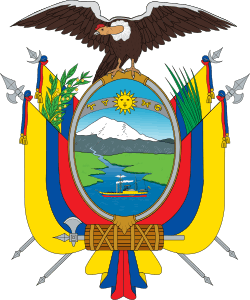Mining in Ecuador
| Economy of Ecuador |
|---|
 |
| Overview |
|
| Ecuador topics |
|
Mining had a very small impact on the Ecuadorian economy back in the 1980s, contributing only 0.7 percent to the GDP in 1986 and employing around 7,000 people. Minerals were located in regions with little to no access, thus exploration activities were hindered. Although it was believed that Ecuador had reserves of gold, silver, copper, zinc, uranium, lead, sulfur, kaolin and limestone,the latter practically dominated the industry as it was used in local cement plants.
Gold, which was largely forgotten since its early exploitation in the sixteenth century, regained momentum in the 1980s. Ecuador were exporting 2.4 tons per year by 1987, which was mostly discovered in the southern Sierra region, as well as the southeastern province of Zamora-Chinchipe.
In 1985 Ecuador's Congress passed a new law to encourage foreign exploration and investment. Designed to simplify regulation of the industry, the legislation offered higher financial incentives and lower taxation for investors, while also establishing the Ecuadorian Institute of Minerals (Instituto Ecuatoriano de Minería—Inemin) under the Ministry of Energy and Mines.[1]
Policies during President Rafael Correa's first six years in office slowed mining activity, despite his plans to develop the industry. According to the United Nations, in 2012 Ecuador received less foreign direct investment per person than any other country in Latin America. A new mining law was eventually passed by Congress on 13 June 2013, making Ecuador much more lucrative for foreign investors. "The new law imposes an 8% ceiling on previously open-ended royalties, and streamlines the permits required. Companies won’t pay windfall taxes until they have recouped their investments."[2]
Soon after the law had passed, it was reported that several indigenous groups in opposition of large-scale mining planned to take their cases to the international courts later in the year. Led by Carlos Perez, Ecuador's Confederation of Peoples of Kichwa Nationality (Ecuarunari) had already filed a domestic lawsuit. Perez said, "Mining activity affects our ancestral territories. We will do everything to defend our land and our people. We will go to the Human Rights Commission and, if necessary, to the Inter-American Court of Human Rights, asking for protective measures." The Confederation of Indigenous Nationalities (Conaie) "also filed a suit before the constitutional court asking for a law to carry out prelegislative consultation for people that could be affected by mining." Their president, Humberto Cholango, didn't rule out going to the international courts.[3]
Gold mining
In 2006 geologist Keith Barron and his company Aurelian discovered a large deposit at Fruta del Norte, estimated to be 10 million ounces of gold and 14 million ounces of silver.[4][5] Following changes to Ecuadorian mining laws that limited foreign ownership of mining projects, the Canadian company Kinross Gold acquired Aurelian Resources in 2009 and took on the Fruta del Norte project, which is set in the Amazon province of Zamora Chinchipe in southern Ecuador.[5] Described by some as "one of the most exciting gold discoveries of the past 15 years," it has an estimated reserve of 6.8 million ounces of gold and 9.1 million ounces of silver. Despite the project's potential, and just days before Congress passed the new mining law, Kinross pulled out of Ecuador after a dispute over windfall tax. As a result, they took a charge of $720 million.[6][7][8] In 2014 Kinross sold its entire interest in the Fruta del Norte project to Fortress Minerals Corporation.[9][10]
References
- ↑ U.S. Library of Congress. "Mining and Minerals". Country Studies. Retrieved 23 July 2013.
- ↑ "As Brazil raises its mining royalties, Ecuador cuts its own". The Economist. 22 June 2013. Retrieved 23 July 2013.
- ↑ Mercedes Alvaro (11 July 2013). "Ecuador Indigenous Groups Plan Suits Against Mining Activity". The Wall Street Journal. Retrieved 23 July 2013.
- ↑ "He Struck It Rich in Ecuador. Now He's Looking for the Lost Cities of Gold".
- 1 2 "The Barron is back - MINING.com".
- ↑ Joe Leahy (11 June 2013). "Kinross Gold scraps $1.3bn Ecuador project". The Financial Times. Retrieved 23 July 2013.
- ↑ Patricia Rey Mallén (13 June 2013). "Canadian Gold Giant Kinross Pulls Out Of Ecuador Mine Project, Will China Take Its Place?". International Business Times. Retrieved 23 July 2013.
- ↑ "Subscribe to read". Financial Times.
- ↑ Alvaro, Mercedes (22 October 2014). "Kinross to Sell Interest in Ecuador's Fruta del Norte Gold Mine to Fortress" – via www.wsj.com.
- ↑ Editorial, Reuters. "UPDATE 1-Kinross to sell halted Ecuador gold project to Lundin company".